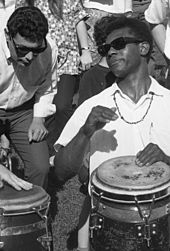Drummer
This article has multiple issues. Please help improve it or discuss these issues on the talk page. (Learn how and when to remove these template messages)
|



A drummer is a
Most contemporary western
Particularly in the traditional music of many countries, drummers use individual drums of various sizes and designs rather than drum kits. Some use only their hands to strike the drums.[1]
In larger ensembles, the drummer may be part of a rhythm section with other percussionists playing. These musicians provide the timing and rhythmic foundation which allow the players of melodic instruments, including voices, to coordinate their musical performance.
Some famous drummers include:
As well as the primary rhythmic function,[2] in some musical styles, such as world, jazz, classical, and electronica, the drummer is called upon to provide solo and lead performances, at times when the main feature of the music is the rhythmic development. Drummers tend to possess considerable stamina and hands-eyes-legs coordination.
There are many tools that a drummer can use for either timekeeping or soloing. These include cymbals (china, crash, ride, splash, hi-hats, etc.), snare, toms, auxiliary percussion (bells, Latin drums, cowbells, temple blocks) and many others. There are also single, double, and triple bass pedals that drummers may use for the bass drum.
Military
Before motorized transport became widespread, drummers played a key role in
In modern times, drummers are not employed in battle, but their ceremonial duties continue. Typically buglers and drummers mass under a sergeant-drummer and during marches alternately perform with the regiment or battalion ensembles.
Military-based musical percussion traditions were not limited exclusively to the western world. When Emir Osman I was appointed commander of the Turkish army on the Byzantine border in the late 13th century, he was symbolically installed via a handover of musical instruments by the Seldjuk sultan. In the Ottoman Empire, the size of a military band reflected the rank of its commander in chief: the largest band was reserved for the Sultan (viz. his Grand Vizier when taking the field). It included various percussion instruments, often adopted in European military music (as 'Janissary music'). The pitched bass drum is still known in some languages as the Turkish Drum.
Military drumming is the origin of
Parades
The
Cultural drumming
Various indigenous cultures use the drum to create a sense of unity with others especially during recreational events. The drum also helps in prayers and meditations.[4]
-
A drummer in a parade, 2008
-
TheKate visited Yellowknife, NWTon July 5, 2011.
See also
References
- ISBN 978-0-7390-0324-4.
- ISBN 978-0-7935-1526-4.
- ^ "Is Traditional Grip Dead? - Drumeo Beat". Free Online Drum Magazine | The Drumeo Beat. 21 July 2021. Retrieved 12 July 2023.
- ^ "Dene Kede - Kindergarten to Grade 6 Curriculum Documents". p. 15. Archived from the original on 26 August 2016. Retrieved 1 May 2015.
- Schlesinger, Kathleen (1911). . In Chisholm, Hugh (ed.). Encyclopædia Britannica. Vol. 8 (11th ed.). Cambridge University Press. p. 598.


